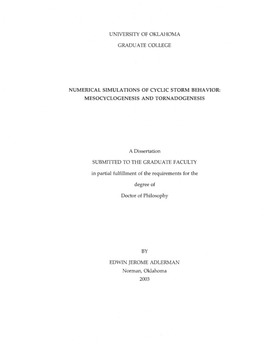| dc.contributor.advisor | Droegemeier, Kelvin, | en_US |
| dc.contributor.author | Adlerman, Edwin Jerome. | en_US |
| dc.date.accessioned | 2013-08-16T12:19:15Z | |
| dc.date.available | 2013-08-16T12:19:15Z | |
| dc.date.issued | 2003 | en_US |
| dc.identifier.uri | https://hdl.handle.net/11244/672 | |
| dc.description.abstract | Building upon previous work that examined the dynamics and model sensitivity of cyclic mesocyclogenesis, this study uses idealized numerical simulations to investigate the cyclic redevelopment of vertical vortices in supercell storms. The study is comprised of two parts. First, we examine the environmental parameter space that delineates between the timing and modes of mesocyclone occlusions. Second, we use a high-resolution numerical simulation to examine cyclic tornadogenesis. | en_US |
| dc.description.abstract | Backward trajectories through the mesocyclone show that when development occurs in an area relatively free of influence from the previous cycle, parcels generally descend through the rear-flank downdraft (RFD) or ascend from east and northeast of the gust front. However, when the mesocyclone of a new cycle develops in close proximity to that of an occlusion, some parcels are recycled through the occluding mesocyclone or the occlusion downdraft. | en_US |
| dc.description.abstract | In the cyclic tornadogenesis study, we simulate a storm that undergoes six mesocyclone cycles during a five-hour simulation. Three of the mesocyclone cycles are tornadic, with one cycle containing two instances of tornadogenesis. The evolution of each mesocyclone occlusion is similar to that in the previous conceptual model, although the details of each transition period (from one cycle to the next) vary significantly. | en_US |
| dc.description.abstract | Backward trajectories through two of the simulated tornado cyclones demonstrate that parcels entering the strongest circulation travel near the ground through a baroclinic zone northwest of the mesocyclone. Parcels along the periphery of the tornadic mesocyclone have more varied histories depending on the details of a particular cycle. In general, they originate at higher levels, with some ascending through the updraft before descending in the occlusion downdraft. | en_US |
| dc.description.abstract | For the parameter study, we examine variations in hodograph shape, shear magnitude, shear distribution, and CAPE. We simulate storms whose behavior ranges from steady-state to varying degrees of occluding cyclic mesocyclogenesis. However, we also demonstrate that a new mode of non-occluding cyclic mesocyclogenesis may occur in certain environments. The preferred mode of cycling is strongly related to both the hodograph shape and the strength of the shear. | en_US |
| dc.format.extent | ix, 217 leaves : | en_US |
| dc.subject | Tornadoes. | en_US |
| dc.subject | Occluded fronts (Meteorology) | en_US |
| dc.subject | Severe storms. | en_US |
| dc.subject | Physics, Atmospheric Science. | en_US |
| dc.title | Numerical simulations of cyclic storm behavior: Mesocyclogenesis and tornadogenesis. | en_US |
| dc.type | Thesis | en_US |
| dc.thesis.degree | Ph.D. | en_US |
| dc.thesis.degreeDiscipline | School of Meteorology | en_US |
| dc.note | Source: Dissertation Abstracts International, Volume: 64-10, Section: B, page: 4989. | en_US |
| dc.note | Adviser: Kelvin Droegemeier. | en_US |
| ou.identifier | (UMI)AAI3109067 | en_US |
| ou.group | College of Atmospheric & Geographic Sciences::School of Meteorology | |
